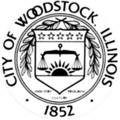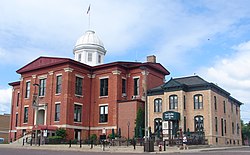Woodstock | |
|---|---|
 The landmark Woodstock Opera House building in historic downtown Woodstock | |
| Motto: "True to Its Past; Confident of Its Future" | |
 Location of Woodstock in McHenry County, Illinois. | |
| Coordinates: 42°18′53″N88°26′51″W / 42.31472°N 88.44750°W | |
| Country | United States |
| State | Illinois |
| County | McHenry |
| Townships | Dorr, Greenwood, Hartland, Seneca |
| Founded | 1852 |
| Government | |
| • Mayor | Michael Turner |
| Area | |
• Total | 13.19 sq mi (34.15 km2) |
| • Land | 13.19 sq mi (34.15 km2) |
| • Water | 0 sq mi (0.00 km2) |
| Population (2020) | |
• Total | 25,630 |
| • Density | 1,943.6/sq mi (750.41/km2) |
| Time zone | UTC-6 (CST) |
| • Summer (DST) | UTC-5 (CDT) |
| ZIP Code(s) | 60098 |
| Area codes | 815/779 847/224 |
| FIPS code | 17-83349 |
| Wikimedia Commons | Woodstock, Illinois |
| Website | www.woodstockil.gov |
Woodstock is a city in and the county seat of McHenry County, Illinois, United States. It is located 51 miles northwest of Chicago, making it one of the city's outer-most suburbs. [2] Per the 2020 census, the population was 25,630. [3] The city's historic downtown district and turn-of-the-century town square is anchored by the landmark Woodstock Opera House and the Old McHenry County Courthouse. In 2007 Woodstock was named one of the nation's Dozen Distinctive Destinations by the National Trust for Historic Preservation. [4]
Contents
- History
- Early days, Centerville
- Eugene V. Debs' prison stay
- "Typewriter City"
- Orson Welles and the Todd School for Boys
- Geography
- Demographics
- 2000 Census
- Local culture
- Local newspaper
- Music
- Religion
- Roles in popular media
- Economy
- Top employers
- Transportation
- Public transit
- Major roads
- Education
- Notable people
- References
- External links














